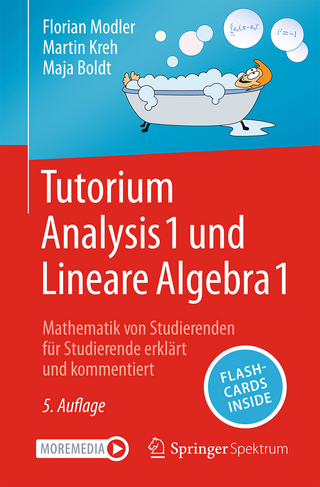
Introduction to Probability
Springer-Verlag New York Inc.
978-0-387-96319-8 (ISBN)
1-Introduction and Preliminary Concepts.- 1.1-Random Phenomena.- 1.2-Elements of Set Theory.- 1.3-A Classical Concept of Probability.- 1.4-Elements of Combinatorial Analysis.- 1.5-The Axiomatic Foundation of Probability Theory.- 1.6-Finite Sample Spaces.- 1.7-Fields, ?-Fields, and Infinite Sample Spaces.- 1.8-Conditional Probability and Independence.- Problems.- 2-Random Variables.- 2.1-Definition.- 2.2-Discrete Random Variables.- 2.3-Continuous Random Variables.- 2.4-Random Vectors.- 2.5-Independence of Random Variables.- Problems.- 8-Distribution and Density Functions.- 3.1-Distribution Functions.- 3.2-Properties of Distribution Functions.- 3.3-The Decomposition of Distribution Functions.- 3.4-Discrete Distributions and Densities.- 3.5-Continuous Distributions and Densities.- 3.6-Mixed Distributions and Densities.- 3.7-Further Properties and Comments.- 3.8-Bivariate Distributions.- 3.9-Bivariate Density Functions.- 3.10-Multivariate Distributions.- 3.11-Independence.- 3.12-Conditional Distributions.- Problems.- 4-Expectations and Characteristic Functions.- 4.1-Expectation.- 4.2-Moments.- 4.3-The Bienayme — Chebychev Theorem.- 4.4-The Moment Generating Function.- 4.5-The Chernoff Bound.- 4.6-The Characteristic Function.- 4.7-Covariances and Correlation Coefficients.- 4.8-Conditional Expectation.- 4.9-Least Mean-Squared Error Prediction.- Problems.- 5-The Binomial, Poisson, and Normal Distributions.- 5.1-The Binomial Distribution.- 5.2-The Poisson Distribution.- 5.3-The Normal or Gaussian Distribution.- 5.4-The Bivariate Normal Distribution.- 5.5-Rotations for Independence.- Problems.- 6-The Multivariate Normal Distribution.- 6.1-The Covariance Matrix.- 6.2-The Bivariate Normal Distribution in Matrix Form.- 6.3-The Multivariate Normal Distribution.- 6.4-MiscellaneousProperties of the Multivariate Normal Distribution.- 6.5-Linear Transformations on Normal Random Variables.- Problems.- 7-The Transformation of Random Variables.- 7.1-Discrete Random Variables.- 7.2-Continuous Random Variables; The Univariate Case.- 7.3-Continuous Random Variables; The Bivariate Case.- 7.4-Continuous Random Variables; A Special Case.- 7.5-Continuous Random Variables; The Multivariate Case.- Problems.- 8-Sequences of Random Variables.- 8.1-Convergence in the Deterministic Case.- 8.2-Convergence in Distribution.- 8.3-Convergence in Probability.- 8.4-Almost Sure Convergence.- 8.5-Convergence in r-th Mean.- 8.6-Relations Among Types of Convergence.- 8.7-Limit Theorems on Sums of Random Variables.- 8.8-The Weak Law of Large Numbers.- 8.9-The Strong Law of Large Numbers.- 8.10-The Central Limit Theorem.- Problems.- Appendices.- Appendix A — The Riemann-Stieltjes Integral.- Appendix B — The Dirac Delta Function.- Appendix C — Interchange of Order in Differentiation and Integration.- Appendix D — Some Elements of Matrix Theory.- Appendix E — The Differentiation of a Definite Integral.- Appendix F — A Monotone Non-Decreasing Function.- References.- Table I-The Unit Normal Distributions.
| Reihe/Serie | Springer Texts in Electrical Engineering |
|---|---|
| Zusatzinfo | X, 250 p. |
| Verlagsort | New York, NY |
| Sprache | englisch |
| Maße | 155 x 235 mm |
| Themenwelt | Mathematik / Informatik ► Mathematik ► Algebra |
| Mathematik / Informatik ► Mathematik ► Angewandte Mathematik | |
| Mathematik / Informatik ► Mathematik ► Wahrscheinlichkeit / Kombinatorik | |
| Technik ► Elektrotechnik / Energietechnik | |
| ISBN-10 | 0-387-96319-7 / 0387963197 |
| ISBN-13 | 978-0-387-96319-8 / 9780387963198 |
| Zustand | Neuware |
| Informationen gemäß Produktsicherheitsverordnung (GPSR) | |
| Haben Sie eine Frage zum Produkt? |
aus dem Bereich


